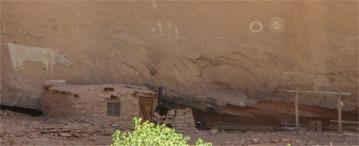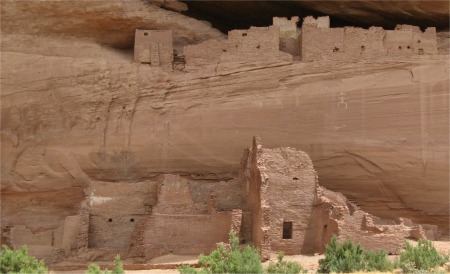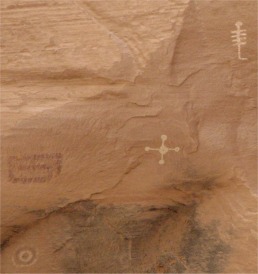 Pictographs (Note the Negative Version of a Hand) |
I turned up at the appointed departure time, and all travelers climbed aboard the 4WD. I was the last one to climb on board, and the guide gave me a funny look. "Just you", he said. I replied in the affirmative. "We normally have couples", he replied. I let it go. I have come across this a lot in restaurants, outings etc, America doesn't expect individuals, it generally expects at least two. Being on my own can be bad enough at times, never mind somebody pointing it out to you. But, hey, life is too short for getting upset about it.
The trip was a shortened version of what I had covered the previous day. It only went as far as the Navajo Fortress near the confluence of Canyon del Muerto and Black Rock Canyon, and as far as the White House in Canyon de Chelly. It gave me the chance to see some of the dwellings I had seen from high up, but now from canyon floor level. It also allowed me to see a host of pictographs and petroglyphs, something that I couldn't pick out from the rims.
I had the chance to chat to a pleasant couple from Arizona for the length of the journey, which made it even more enjoyable. The chap had the driest sense of humour I had found yet in an American.
 Canyon Petroglyphs |
Archaic 2500-220B.C. The earliest inhabitants lived in seasonal campsites located in rock shelters. These small mobile groups embarked on hunting and gathering expeditions, covering familiar territory on the canyon floor and upland plateau. Basketmaker 200B.C-750A.D. About 2,500 years ago a fundamental change occurred in how people lived here. Instead of relying on hunting and gathering, a group called Basketmaker, named because of their extraordinary weaving skills, learned how to farm. Fields tucked into corners of the canyon or on the mesas were small and subject to failure. Over time farming techniques improved, leading to a consistent supply of corn, squash and beans. Pueblo 750-1300 About 1,250 years ago the dispersed hamlets gave way to a new kind of settlement, the village. Why the change occurred was unclear. Perhaps rock shelter households became too crowded. Perhaps conflict forced people to band together for defence. Maybe it was because they wanted to live closer to their farms. These people raised turkeys for food and grew cotton, a crop that led to new weaving techniques. Hopi 1300-1600 Puebloan life ended here about 700 years ago, similar to the Mesa Verde and Hovenweep communities. They moved south and west, establishing villages along the Little Colorado River and at the southern tip of Black Mesa. In time, these people became the Hopi. Navajo 1700-1863 The Navajo, an Athabaskan-speaking people, entered Canyon de Chelly about 300 years ago. They brought domesticated sheep and goats acquired from the Spanish and a vigorous culture tempered by centuries of migration and adaptation. Like those before them, the Navajo used the canyons and the plateau to support a way of life. Tranquility ended in the late 1700s as warfare erupted between the Navajo, other tribes, and Spanish colonists. Despite the elaborate defence mechanisms deployed by the Navajo, Spanish, Ute and US military parties penetrated the defences leaving death and destruction in their wake. The Long Walk 1863-1868 In 1846 a US military force under Stephen Watts Kearny subdued Mexican forces, claiming what is now Arizona and New Mexico as US territory. Kearny offered the Navajo peace in order to end decades of mutual raiding between tribes. For the next 17 years this agreement was tested by continued conflict, broken promises, and military expeditions into Navajo territory. In 1863 Col. Kit Carson began a brutal campaign against the Navajo. In the winter of 1864 Carson's troops entered the eastern end of Canyon de Chelly and pushed the Navajo toward the canyon mouth. Resistance proved futile; most Navajo were captured or killed. Carson's forces returned in the spring to complete their devastating campaign. They destroyed the remaining hogans, and killed the sheep. A bitter humiliating trial awaited those Navajo who survived the ordeal. Forced to march over 300 miles called the Long Walk, to Fort Sumner in New Mexico territory, scores perished from thirst, hunger, and fatigue. Their years of internment at Fort Sumner were no kinder. In 1868 the Navajo were finally allowed to return home to rebuild their lives. Trading Days 1868-1925 The Navajo returned home to find their hogans, crops, and sheep gone. Again they faced starvation. Food distribution centres, like the one at Fort Defiance in Arizona territory, helped the Indians recover. These centres and practices taken from the Spanish and Mexican traders provided a model for the trading posts that built up in Navajo country. Trading posts became a focal point for Navajo communities, places where men and women exchanged news, discussed problems, and traded rugs, jewelry, and crafts for food and other staples. Sam Day's 1902 trading post at Canyon de Chelly was now part of Thunderbird Lodge's cafe. It was through Thunderbird Lodge that I made my guided trip in the canyon, and hopefully I had in my way, fed something back to the Navajo. The tour concluded and I wished the American couple a good and safe trip. On my return to the campsite, I chatted for a while with my neighbours who I met when I first arrived here. They were a retired couple who were taking their three grandchildren on a seven week tour of the area, in fact almost tracking my itinerary. We were all heading for Page in the morning, though they were making a detour to the Four Corners just so the grandkids could say they stood on Utah, Colorado, New Mexico and Arizona all at the same time. They would have liked to make it across to the west coast, but they had a long haul back to Michigan before them, so they would leave that to another time. The couple did make the west coast many years ago on a motorcycle. I walked across the campsite kicking up clouds of "cottonwool". The ground was white with all the seeds blown off the cottonwood trees. I made the mistake of leaving the van door open for a short while, and the interior soon had its own little snowstorm raging away, a little like those glass ornaments that you shake to create the illusion of a miniature snowstorm. Storm clouds were gathering on the horizon with curtains of rain appearing to reach the ground rather than evaporate half way down. I dashed off for my usual shower, however, by the time I was done, the clouds had caught up with me and torrents of rain were bouncing off the car park. I waited for some time before it eased off. Outside there was a new freshness in the air, and a slight drop in temperature, with an exquisite aroma of hot dusty asphalt recently drenched in rain. Despite the downpour, I could still feel the heat rising from the hot asphalt below me. I drove back to the campsite, and by the time I arrived, all the roads were bone dry again, though soil areas revealed the tell tale signs of recent rain. I watched a couple walk by, about 4m apart, each talking into their own mobile phone. I observed later they were still walking around the campsite loops, talking into their phones, but now 20m apart. Were they talking to each other by mobile, I'll never know. I tried to do some mental arithmetic to ascertain how many laps they would have to do before the chap overtook his other half, but decided life was too short. I would check on them in the morning. As the sun was setting, I was tossing the same thoughts over in my mind that I had at the Big Hole National Battlefield. I still felt it wrong for one segment of the human race to feed its greed and ambitions at the expense of another segment. Then I ask myself how things would have turned out if a policy of live and let live had been adopted. We will never know since it seems to me that the human race never learns and keeps perpetuating the cycle. Canyon de Chelly was another facet of American history that I enjoyed learning about, and it was certainly well worth making the detour across to it. |







